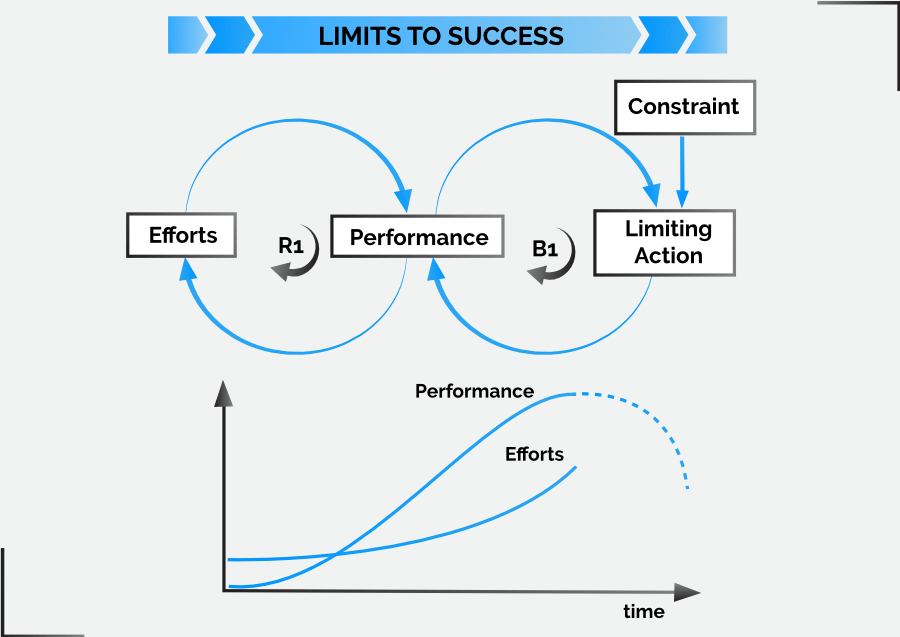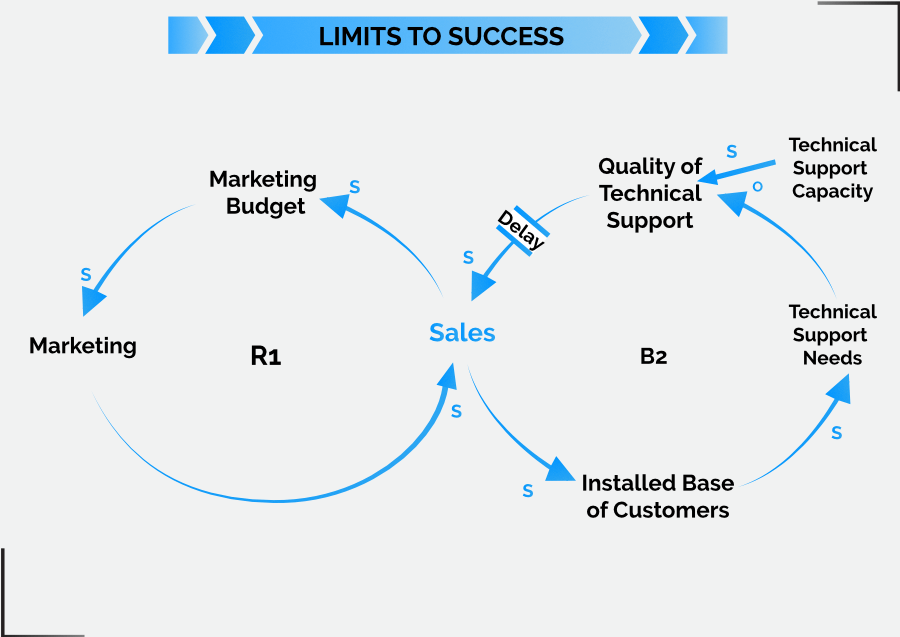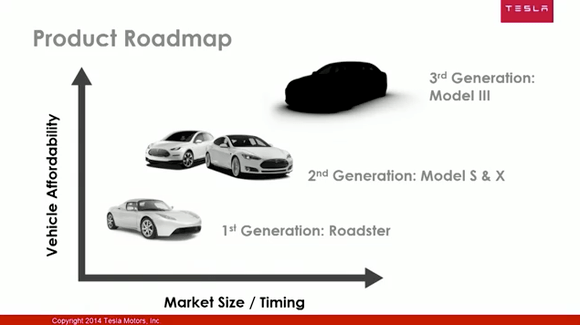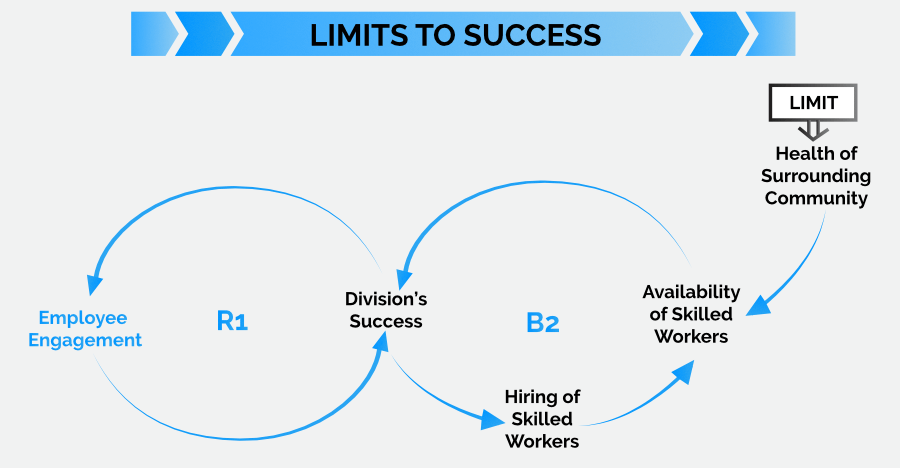Imagine a marketing department launching a new marketing campaign1 that proofs to be highly successful. It leads to a significant growth of the company. Managers are satisfied. High sales bonuses are being paid. But then after a while growth slows down, eventually even declining. What’s going on here? What’s the first inclination of the marketing department? Double the marketing efforts. “We know the method works… so the problem must be somewhere else”. The extra marketing efforts seem to work… for a while. And then sales top off and start declining again. Only faster this time.
This is a very common scenario. In the beginning nothing seems to stand in the way of success. You found your growth engine. It’s like a money machine. But then growth slows down. There is no signal the same methods don’t work anymore so you double your efforts but growth keeps slowing down until results eventually even start declining. You frantically search for the cause. Something must have changed! What?! Where?! Have customer preferences changed all of a sudden? Chances are the company hit a limiting factor to the growth. Almost all growth engines have limiting factors, often unnoticed. The most astounding part is the limit was already there. From the start. It just took a while for it to manifest itself. And because we miss the connection, we miss the fact that we are causing the declining growth ourselves.
This is part two of the Curse of the silos series. We’ll introduce one of the most lethal assassins of the adaptive anti patterns: Limits to success.
This article is part of a series
[series_post_list_box]
What can you expect from this article?
- Discover the adaptive ant-pattern Limits to Success
- Discover the surprising fact that a growth scenario usually carries the seeds of decline in it already.
- Understand how the silo structure in our organizations cause and increase the effect of the pattern.
- Learn a step by step aproach to prevent the pattern form happening
The Limits to Success archetype
The Limits to success causal loop diagram. Source: Daniel Kim
Here we see the circular nature of cause-effect relationships: Our efforts lead to growth and the growth allows us to increase our efforts, again leading to more growth. The limiting factor is also a loop but a balancing loop, one that tries to reach a certain state. The balacing loop counters the effects of the reinforcing loop.
Example of Limit to Succes. Source: Daniel Kim
Let’s return to our example. Marketing efforts lead to an increase in performance. But because of the success we will probably increase the same marketing efforts. Also, because of higher sales, the marketing budget increases which leads to a higher marketing effort, which in turn leads to higher sales. It is a reinforcing loop, typical for a growth engine. So initially the performance of the marketing efforts is much higher than the efforts involved. But as we said, almost any growth engine has a limiting factor. Here the higher sales numbers lead to an increasing installed base of customers. Several of those customers need technical support. The total number of customers that need technical support is growing simply because the number of customers is growing. At some point the department can’t keep up anymore which slowly leads to a decrease of the support quality provided. Eventually this will hurt our reputation and lead to a reduction in sales. You can see how the balancing loop counter-balances our growth engine reinforcing loop. There is often a delay involved. In this case it takes a while before customer support has become so bad that we start loosing customers because of it.
The initial inclination of the marketing department is to increase their efforts. They have no signs their instruments don’t work anymore. But now the limiting counter-balancing loop is already at full speed, meaning the increased marketing efforts do not have the same results they used to have. Maybe there is a slight increase in sales but it will probably top off soon again. As we continue down this path the performance curve and efforts curve approach each other. And if we don’t identify the limiting factor, growth can be turned into decline despite all efforts.
The curse of the silos
Did Tesla’s growth engine hit a limit?
Let’s look at a real case. Tesla is highly effective in disrupting the car industry. Not only did they innovate the decades old car sales model using a direct, dealer-less model, they pioneered over-the-air car updates whereas with any other car brand you are lucky if any updates get installed during a service visit to the dealer. Plus, of course they popularized the full electric car. Elon Musk seems to have carefully planned out every step of the company’s progression. He proofed there was a market without having to spend all the capital and effort to design an entire car. He did this by licensing the Lotus Elite and relaunching it as the first Tesla model. The original Tesla Roadster was a very expensive car never meant to sell a lot. He used the experience to develop the model S, still an expensive car but within reach of more people and the model S is a more mainstream design, appealing to a larger audience. This launch allowed him to disrupt the market without the need for the massive production capacity of the established car manufacturers. The next step was the model 3 which should ready the company for mass production. The model 3’s purpose is to bring the ownership of a Tesla electric car within reach of the masses.
Tesla strategy. Copyright Tesla Motors Inc.
As frustration among the early adopters grows, and the competition is launching new all-electric models in record numbers, the question is how this will turn out for Tesla in the long run. If Tesla seems to have planned everything so carefully, couldn’t they have seen this coming? The first answer is that this proofs once again that linear planning simply does not work in complex environments. There are too many variables in play to consider. Secondly, they might have seen it coming, but simply too late. Third, it would be interesting to analyze in more detail what the actual limiting factors at Tesla are. The outcome could be surprisingly more complex and diverse than just simply production capacity. So, if we cannot assume our growth engine to keep on running on its own forever, and we can’t simply plan success, then what to do?
How to overcome limits to growth?
The Caterpillar case
From 1996 on, Caterpillars business unit in Brazil, located in the city Piracicaba, launched an ambitious improvement program based on employee engagement. This program not only turned the dwindling results around but also earned the company the country’s most prestigious quality award. Even today Caterpillar Brazil remains to be the company’s top performer in terms of financials results and employee engagement.
However, at some point management started to realize the facility rested heavily on its community to provide skilled workers. But as the urban area the facility was located in was suffering from high crime rates and an underperforming education system it became clear that the limited supply of skilled workers could threaten the sustainability of the company’s success.
Barriers to succes at Caterpillar Brazil. Source: The SystemsThinker – JANICE MOLLOY, KALI SAPOSNICK
The company started local education and health initiatives. They also launched a more ambitious program called Piracicaba 2010 to bring together local officials, entrepreneurs, media and others to attract talent to the city. While Caterpillar jumpstarted the program by offering resources, many of it employees volunteered to spend their own time to help. And within six months this snowballed into community participation. The Piracicaba 2010 project even became an example to the Brazilian government to launch similar initiatives to revive the cities of Brazil.
Realize the limits to growth are already there
Caterpillar Brazil identified the limiting factor to it growth before it manifested itself as a source of decline. They succeeded in overcoming the limits and continue to keep the growth engine running smoothly. Every growth will hit some limit eventually. The trick is to not wait for it. By then pressure is up to come up with a solution which increases the chance we go for short-term fixes instead of looking for root causes (see fixes that fail). If you react to late you will be running out of resources making it very hard to respond adequately. Take f.e. Toys ‘R US: by the time the company really started to take Amazon’s competition seriously and started investing in an e-commerce position of it’s own, the company was suffering from high debts and simply didn’t have the capital anymore to launch an effective response. There are many examples like Toys ’R US, a situation that is not to be envied. Try to avoid the “We’re doing pretty ok as it is” trap. Act pro-actively.
The following step by step aproach to overcome the limits to growth are derived from Daniel Kim, a reputable Systems Thinker.
1. Identify growth engines
To be able to identify limits to growth we must identify the growth engine itself first. For every value proposition try to identify the growth engines. Try not to simply focus on success factors that lead to growth but try to find reinforcing loops that lead to growth. A reinforcing loop is a growth engine that regenerates itself once we fuel it. There can be several.
2. Identify potential limits to growth
Now try to envision a time horizon needed for achieving such substantial growth that it will outstrip a current capacity of some kind. This can be support capacity as we saw in the example earlier. But there are many other potential ones like logistics, quality control, production capacity, and others. We try to find limits in capacity that might become a problem in the future, not so much problem syou already have. It can be some physical capacity like production machines; a limit in information systems; a capacity limit in the number of (qualified) people; a knowledge or expertize limit; or a limit coming from mental models: we unconsciously limit ourselves in ideas, possibilities, and solutions based on entrenched world views.
Realize that mental models can stand in the way of identifying potential growth limits. They can cause a bias leading to look in certain directions only. You need some creativity to get past mental models. It is also best to do this exercise in a varied group of representatives from several silos. Create an atmosphere where people feel free to challenge each other. Do make sure to separate diverging from converging: Gather ideas without criticizing first. Allow the wildest ideas. Only then start punching holes in ideas to find the realistic ones.
3. What change is needed?
It’s helpful to draw limits in counterbalancing loops to get a better idea of the way they will potentially affect growth. We then focus on the changes that would be needed to lift each limit. Do we need more people? What training do they need? When do we expect to need them? It is important to realize that in this phase you are making a lot of assumptions. Your reinforcing loops; the limits you identified and the way they play out in counterbalancing loops… all assumptions that need to be rigorously tested.
Define a Growth Limit Hypothesis Statement for each assumption in a form like this: We hypothesize that by [making this change] we expect to get [this effect] which will help lift [this limit]. We test this by [these metrics]. Don’t try to skip this phase because you think that some of the planned changes are so logical they do not need testing. That’s a deadly trap. In complex systems there are many factors at play and you cannot always see them upfront.
4. Assess Time & investment Needed to Change
Estimate the time needed to lift the limits you identified. How long does it take to modify the information system, for example. How long does it take to train people? There are two important factors here:
Make sure you estimate the time needed without disrupting the growth engine. Otherwise you might be creating limiting factors yourself.
It is key to find solutions that take less time to implement than the time you estimated for the limit to manifest itself. Otherwise you will still run into the limits to growth.
Estimate the investments it takes to lift the limits. Required investments should of be proportional to the growth. It makes no sense to invest more in lifting limits to growth than the growth engine can produce in the foreseeable time.
5. Balance growth
If you don’t have the time to lift the limits before you estimate they will start limiting growth, or you cannot justify the investments needed, there is one more action to take: balance the two loops. This is controversial because it might mean you need to slow down growth to lessen the effects of the counter-balancing loop. But at least it means you are still in control. The alternative is to let the Limits to success trap take over and see your company’s success spiral downwards.
6. Keep monitoring
Make sure you monitor the potential limits to growth and are continuously on the lookout for other ones. Today’s’ organizations are complex systems in which any small change can have serious consequences elsewhere. Don’t assume you can plan your engine of growth and limiting factors and live happily ever after.
You can easily see why doing this in isolation in silo’s makes little sense. We need everyone involved in all activities that make up the value stream to have a fighting chance of identifying causal relationships that can affect our engines of growth.
In the Tesla case we could conclude that the company hit a limit in production capacity and just didn’t see it in time or didn’t respond adequately. But it could very well be more complicated. There could be other limiting factors at play. Perhaps Tesla identified growing competition as a limiting factor to its growth, and they concluded they had a limited time window to make the model 3 a success. They might have considered this limit to be a higher risk and launched the model 3 without being sure they were ready for it. But that shifted the burden to production, showing how complex things can get. Balancing the two loops was hard in their case because of all the pre-production reservations.
Conclusion
The limits to success archetype shows us that any growth engine already carries in it limits to that growth. We tend to look at external reasons for a decline in performance, although many times we are causing it ourselves. Yet, because we fail to see the connection between effects of the limit and our actions, we still fall in to the trap. The silo structure prevents anyone from seeing the whole picture. Cause-effect relationships are predominantly identified within silos, not across. This is aggravated by the delays that occur before the growth limits kick in.
Identifying and overcoming potential limits to growth before they manifest themselves is crucial for sustainable growth. The modern organization must be able to continuously reinvent itself by identifying, exploiting, and withdrawing from new opportunities before they go stale. In this light it is even more crucial not to fall into the trap of limits to success.
Bibliography
List of notes and sources we reference from.
Notes
- Example adapted from Daniel Kim. USING “LIMITS TO SUCCESS” AS A PLANNING TOOL. https://thesystemsthinker.com/using-limits-to-success-as-a-planning-tool/
- Tesla Model 3 sales rev up in first quarter, outpace other electric cars in U.S. https://www.digitaltrends.com/cars/tesla-model-3-best-selling-electric-car/
- Tesla Starts Fulfilling Model 3 Pre-Orders From New Customers. http://fortune.com/2018/02/25/tesla-model-3-preorders/
- You can also style every aspect of this content in the module
- Design settings and even apply custom
- CSS to this text in the module
- Advanced settings.
Follow this article
You can choose to follow this article in which case you will be notified when there there are updates of the article. You can also choose to follow all articles of this category. You will then be notified if a new article is added in this category.









